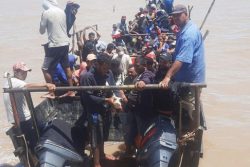While piracy has been a persistent problem along the coast in recent years, the discovery of bound bodies of fishermen and the disappearance of others has introduced a deadly twist and left the police with major mystery on their plate.
Relatives are still querying who might have been responsible for the murders of the men; about the fate of those still missing and what further action will be taken by police and the government.
There have been dozens of attacks, which resulted in millions of dollars in losses to fishermen, including boats and equipment and brutality. However it was not until October that lives were lost as a result of piracy, piling pressure on the government to do something about the continuing rampage by high-seas bandits.
On October 25 last, a fisherman bumped into the first bound body as he was going to check his seine. He immediately turned back and alerted his son and a brother who had a closer look. The man’s hands and feet were tied together in front. His body, almost in a crouching position, was braced against a mangrove tree. He appeared to be “nicely dressed” in a pair of “greyish” shorts and cream-coloured t-shirt, Stabroek News was told.
The second body was discovered two days later. Initial reports had stated that a gardener from Whim saw the other body on the shore in the vicinity of his fishpond and a report was made at the Whim station. He said the body, which seemed to be swollen was clad in a pair of ‘three-quarter’ light-coloured pants and black sleeveless t-shirt and was found facedown. The hands and feet were bound together at the back. He said a part of the left foot below the knee appeared to have been bitten off. Both bodies were kept at a funeral home in New Amsterdam for weeks.
After no one claimed them, and believing that the men were not Guyanese, the local authorities contacted their counterparts in Suriname for assistance in identifying the men. However, after investigating, the Surinamese investigators said the men were not from that neighbouring country. A woman from Trinidad and Tobago also came to see if the bodies were those of her two brothers Edgar, 39, and Vinton Frank, 49, who had been missing since July. The brothers left Grenada in their cabin cruiser Reel Lucky and had not been seen since. However, dental records showed that the bodies were not those of the Trinidadians.
There were reports in the local media that police believed the men might have been foreigners. Investigators said they believed the men were victims of a piracy attack and had speculated that the men, being foreigners, were killed on board a vessel and tossed into the sea. Throughout the investigations police held onto to the theory that the men were foreigners who were attacked by pirates and killed.
Meanwhile, a third badly decomposed body was discovered at the Whim foreshore by a fisherman on November 8.
Rameshwar Gangadin, his brother Navendra Gangadin, Patrick Parboo, his cousin Davendra Persaud, Christopher Rooplall and Mark Sylvester Parshram left on a fishing trip on October 12 and were never seen or heard from again. This began to worry relatives who said that the fishermen would normally not stay longer than 18 days at sea.
It was only on November 7 that relatives sought the help of the Agriculture Minister Robert Persaud and this was when the story of the missing men came to light. After the meeting, the ministry and the coast guard afforded the relatives of the six fishermen an aerial search up the Corentyne River in search of the missing men. The relatives had been advised by persons to contact the police in Berbice about the bound bodies, but were not ready to accept that their loved ones had been murdered at sea. Relatives said it never dawned on them to check the bodies that had washed up several weeks ago, since they were told that the bodies were those of Caucasians.
However, after coming to grips with the possibility that the bodies might have been those of the missing fishermen, relatives decided to visit the ancient county. The bodies were already buried because of the state they were in. Nevertheless, the relatives of Rameshwar Gangadin, Mark Sylvester Parshram and Patrick Parboo managed to identify the men from pieces of clothing that were shown to them by investigators. Having done this, relatives asked that the bodies be exhumed and given to them for burial. This was granted.
Meanwhile relatives of the remaining three men, Navendra Gangadin, Christopher Rooplall and Davendra Persaud said they have not yet given up hope that the remains of their loved ones would be found.
The trip at sea
When they left for sea on October 12, the six fishermen were expected back home by October 30 the latest. A relative, who is also a fisherman, said he had caught up with the six men in the Corentyne area. He recalled taking cigarettes and soft drinks from the men who were at the time heading further up the Corentyne River. The relative said he spotted the missing men some five days after they left for their trip, while he and his crewmembers were heading home from their trip at sea. He added that some time around October 24, his crewmembers were attacked by pirates in the same Corentyne area.
The relative said he believed that the men had already been attacked and killed then, since he saw the pirates using a screwdriver that looked like one the six Annandale fishermen left for the sea with. “Mi recognize de screwdriver and when mi reach home mi tell mi sister dat mi think dem boys get kill at sea. But nobody nah listen to me







